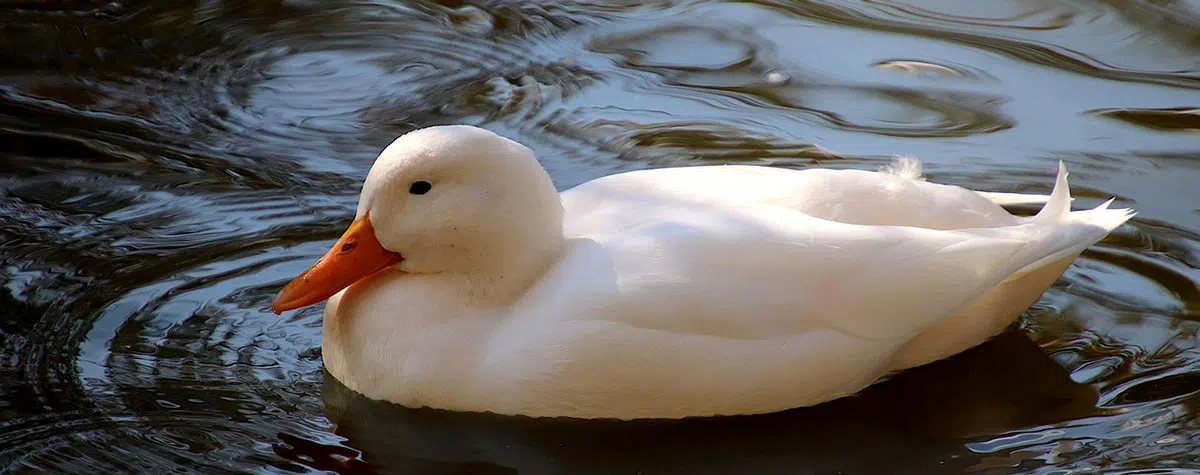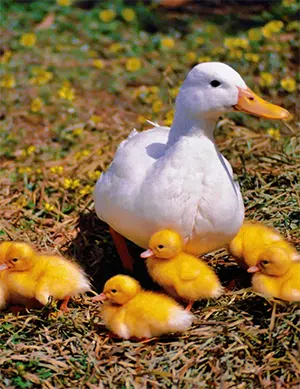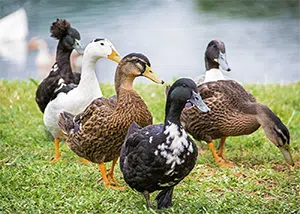Did you know that there are 29 different species of ducks in Canada alone? Waterfowl are found throughout the world and include flightless species as well as those undertaking long migrations. Ducks got their name from the old english verb ducan (to duck or dive); ducks are named for what they do - ducking underwater to procure their meals.

Average Lifespan of Ducks
The average lifespan of a duck is 8 to 12 years. Just like with dogs, the bigger the duck, the shorter the lifespan. Now, technically, geese and swans also belong to the Anatidae family - an umbrella term for water fowl. Let's look at differences in longevity between wild and domestic ducks. Not average by any means is a pair of ducks in South Africa who, according to the Guinness Book of World Records, lived to the ripe old age of 49!
Wild Ducks vs. Domestic Ducks
Wild ducks live 8 to 10 years, or thereabouts. Domestic ducks, on the other hand, can live as long as TWENTY years or more - if healthy and with proper care. That is quite a discrepancy. Let's have a closer look at what determines the lifespan of a duck and what duck keepers can do to prolong the life of their charges.

Wild Ducks
Determining avian lifespan really depends on when you start counting. If we are talking about eggs (before hatching), the numbers are devastating. Out of 100 eggs only 15 will hatch. Once hatched, about half of the ducklings will fall prey to predators. Once ducks are able to take flight, the odds increase dramatically and keep increasing with age. In conclusion, wild duck survival is mostly determined by the first year of life.
Domestic Ducks
A well loved and cared for domestic duck can easily live to the age of 20 and even beyond. With a sturdy and predator safe enclosure, plenty of clean water and an ample food supply - their life is one of leisure. That doesn't mean there are no threats. Pond duck longevity can be curtailed by a host of diseases. You'll need to monitor your domestic duck flock for signs of:
- Mycosis
- Non-specific diarrhea
- Salmonellosis
- Sinusitis
- Spirochaetosis
- Rickets
- Vitamin A deficiency
- White eye
Factors Affecting Duck Lifespan
Ducks are hardy birds that can survive in many environments all over the world. This is particularly remarkable in northern climates, where the birds face harsh winters and compete for a limited amount of food. Let's explore the factors affecting duck lifespan in more detail:
Species Variations
Again.. the larger they are, the shorter their life. Unfortunately, that is true for many species - not just waterfowl. But aside from that, some species are definitely more hardy (or skilled at survival) than others. At the top of the longevity list according to hunting records sits the Mallard Duck with the oldest shot at 27 years old, while 20 years of age was oldest reported harvest of a Green Winged Teal Duck. Some species, like the wood duck have a significantly shorter life expetancy - usually not over 4 years.
Gender
There is some evidence that male ducks (drakes) have a higher survival rate and therefore longer livespan than female ducks (hens). This is attributed to reproduction and nesting - 'sitting ducks' as it were, are easier preyed upon than those able to take to the skies.
 Environmental Factors
Environmental Factors
Waterfowl are remarkably adaptable to harsh, cold weather conditions; they carry dense layers of insulating feathers, counter-current blood flow to reduce heat loss through their extremeties, and are able to carry large fat reserves. And, of course, there's migration. The onset and severity of winter weather is known to affect the timing and speed of waterfowl migration. But, occasionally conditions become extreme so suddenly that ducks can find themselves stranded and in a real struggle for survival. We had such an event during the winter of 2013-2014 on the Great Lakes where ducks were starving and dying. While starvation is relatively rare in waterfowl, some species with more restrictive diets or whose preferred foods and habitats are in northern latitudes seem to be more susceptable than others. Those include various diving and sea ducks that forage on mollusks, fish, and crustaceans in large, deep bodies of water, such as red-breasted and common mergansers, white-winged scoters, common goldeneyes, and scaup.
Predation and Human Impact
Ducks have to contend with a fair number of wildlife predators, including, raccoons, skunks, weasels, fox, coyotes, birds of prey, crows, ravens, magpies, snakes, and fish. Wait.. what? Fish? Yep. Muskie, pike and even large snapping turtles are known to hunt and devour ducks. Gulls and other birds may raid duck nests as well.
And then there's us. Humans. With our hunting rifles and our domestic dogs and cats. With our ever expanding developments, turning rural areas wtih quiet lakes into suburbs and bedroom communities.
Lifespan of Common Duck Species
Mallards
Typically, the life span of the mallard in the wild ranges from seven to nine years, although some birds have been documented to live more than 25 years. More than half of hatched mallards die before they reach two years of age. This is fairly typical for all duck species.
Wood Ducks
Wood duck parents do not build their nest on the ground like most other duck species. Instead, they opt for a nest in a tree cavity (such as an abandoned woodpecker hole). This means that very young ducklings must jump out of the high tree cavities onto the ground to make their way to water. Wood ducks typically do not live past the age of four in the wild. In captivitity however, they have been known to live live well into their teens.
Pekin Ducks
Pekin Ducks are also known as American Pekin, White Pekin, or Long Island Duck and are a favorite among duck keepers. They are a dual purpose breed, meaning they're bred for eggs and meat. A Pekin’s lifespan is typically 5-10 years with the average probably around 7 years. Healthy individual Pekins that receive good care may be able to live up to 10-15 years. Jumbo Pekins have particularly short lifespans of around 1-5 years, often dying of heart failure because of their sheer size. Interestingly, Pekins are known to be terrible breeders and/or mothers. They rarely, if ever, go broody and sit on their eggs. Occasionally, one will sit, but even then she'll likely give a less than stellar performance as a mother.
Got a Problem with Ducks? Rely on the Professionals at Hawkeye!
Ducks and geese can become quite an issue on just about any green space in close proximity to water. At Hawkeye Bird & Animal Control, we have developed a great number of non lethal methods to convince our fine feathered friends to vacate the premises and set up house elsewhere. Please remember that ducks and geese (as well as many other birds) are protected under the Migratory Birds Convention Act and you will require a permit for any and all interventions. Call Hawkeye today!














